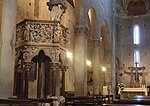Ville Sbertoli
Architecture in ItalyBuildings and structures in PistoiaPsychiatric hospitals in ItalyTherapyWorld Heritage Sites in Italy
Ville Sbertoli (also known as Casa di salute Sbertoli) was a lunatic asylum in Pistoia, Italy. The original structure was built in the 17th century. In 1868, it was bought by Agostino Sbertoli, who wanted to create a health facility for wealthy families. After serving as a political prison during World War II, it was transformed into a public psychiatric hospital in 1951. The complex was later abandoned.
Excerpt from the Wikipedia article Ville Sbertoli (License: CC BY-SA 3.0, Authors).Ville Sbertoli
Via Solitaria, Pistoia
Geographical coordinates (GPS) Address External links Nearby Places Show on map
Geographical coordinates (GPS)
| Latitude | Longitude |
|---|---|
| N 43.953806111111 ° | E 10.918221944444 ° |
Address
Ville Sbertoli
Via Solitaria
51100 Pistoia
Tuscany, Italy
Open on Google Maps











